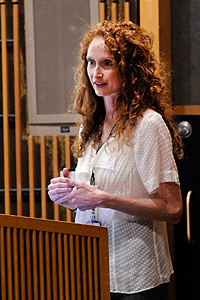NTP board supports systematic review, new carcinogen concepts
By Robin Mackar

Bucher, left, and Eastmond listened intently to the discussions. (Photo courtesy of Steve McCaw)

Birnbaum clearly enjoys spending time talking toxicology with board members. She updated them on the NIEHS strategic planning process. (Photo courtesy of Steve McCaw)
The literature-based analysis capabilities of the National Toxicology Program (NTP) took center stage during its Board of Scientific Counselors meeting June 21-22 at NIEHS.
Ruth Lunn, Dr.P.H., director of the Office of the Report on Carcinogens (RoC), and her staff, were well prepared to present the board with concepts outlining the planned reviews for five substances proposed for potential inclusion in the RoC, while Kris Thayer, Ph.D., and her Office of Health Assessment and Translation (OHAT) team wowed the board with their plans to bring systematic review methodology and new information management tools into their literature-based evaluations.
Systematic review will enhance transparency
“The board is very enthusiastic and supportive of the NTP taking a leadership role in systematic review,” said BSC chair David Eastmond, Ph.D., of the University of California, Berkeley, as he summarized the sentiments of the board, after hearing an engaging presentation by Thayer.
“Systematic review is a scientific investigation that focuses on a specific question, and uses explicit, prespecified methods to identify, select, summarize, and assess the findings of similar but separate studies,” Thayer explained. “It’s traditionally been used for evaluating health care interventions but, from what we’ve seen over the past year, it’s going to be a really powerful tool for conducting our literature-based evaluations and helping NTP develop evidence-based conclusions.”
Thayer stressed that a systematic review does not eliminate the need for expert judgment, nor does it guarantee reproducibility in the overall evidence-based conclusions, but she emphasized how it will enhance transparency and allow for more consistent data collection and evaluation.
A critical initial step of conducting a systematic review, she said, is to develop a protocol, or predefined approach, that outlines how the evaluation will be conducted. Thayer added that the NTP will engage technical experts, interagency partners, and members of the public, to refine the scope of an evaluation and create the systematic review protocol. Thayer finished by walking the board through a series of demonstrations of how a protocol might work from start to finish.
Board member David Dorman, D.V.M., Ph.D., of North Carolina State University, and others, applauded NTP for taking a lead role in bringing this approach to fruition and encouraged the NTP to share these tools with others. “The need for this cannot be overstated,” said new Board member Robert Chapin, Ph.D., of Pfizer. “It will be the shining jewel for the NTP.”
Further enhancing the environment of animals in NTP studies
Angela King-Herbert, D.V.M., who leads the NTP Laboratory Animal Management Group, updated the board on plans to enhance environmental enrichment in rodent studies. King-Herbert explained how environmental enrichment seeks to enhance an animal’s well-being. She said there is not a standardized approach for how this should occur. “It can include, for example, things like ensuring that the animals are socially housed and creating an environment that promotes the animal’s natural behaviors.”
King-Herbert said the approaches for environmental enrichment proposed by NTP are in accordance with the 2011 Guide for the Care and Use of Laboratory Animals. She discussed how the NTP will phase in two different enrichment items, including crinkled natural kraft paper and plastic rectangular shelters, and how the NTP will closely monitor the impact of the enrichment. An NTP animal welfare committee has been established to oversee these activities. The Board discussed the complexities of understanding the potential impacts of environmental enrichment on toxicity studies, but also expressed its strong support for moving forward.
Strategic plan update, green light on genetic toxicity testing
Other meeting items included an update from NIEHS/NTP Director Linda Birnbaum, Ph.D., on the nearly finalized NIEHS strategic plan. “This plan will be a blueprint for the entire field of environmental health sciences,” Birnbaum said.
NTP genetic toxicologist Kristine Witt received the green light from the board, which unanimously voted to approve a concept that would expand the NTP’s genetic toxicity testing capabilities to include human cells. And, OHAT’s Andrew Rooney, Ph.D., received praise for completion of the NTP Monograph on Health Effects of Low-level Lead.
(Robin Mackar is the news director in the NIEHS Office of Communications and Public Liaison.)

King-Herbert outlined plans to further enrich the environment of rodents being used in NTP studies. (Photo courtesy of Steve McCaw)

NTP toxicologist Michelle Hooth, Ph.D., succinctly updated the board on the seven technical reports that were approved by a panel of external experts in February. See story for more details. (Photo courtesy of Steve McCaw)

Thayer enjoyed a positive reception for her update on how NTP is bringing systematic review to fruition in literature-based evaluations. (Photo courtesy of Steve McCaw)

Rooney is all smiles, now that the NTP low-level lead evaluation is completed. (Photo courtesy of Steve McCaw)

Witt was well prepared to respond to questions from the board about how the NTP is planning to broaden the scope of its genetic toxicity testing contract. (Photo courtesy of Steve McCaw)

Board member Richard Miller, D.V.M., Ph.D., of GlaxoSmithKline, provided valuable input on a wide range of topics covered at the NTP meeting, including serving as a reviewer for the pentachlorophenol draft concept for the RoC. (Photo courtesy of Steve McCaw)

Lunn outlined the process for the preparation of the RoC. Lunn and her staff, including Gloria Jahnke, Ph.D., and Diane Spencer, presented the board with five draft concepts for consideration. (Photo courtesy of Steve McCaw)

New NTP board member Chapin was at home at NIEHS and was very supportive of the presentation on systematic review. (Photo courtesy of Steve McCaw)
Report on Carcinogens process in action
As part of the new process (http://ntp.niehs.nih.gov/?objectid=3756DE0C-FA7A-404B-3F72194C30ABD961) for preparing the RoC, Lunn and her staff presented the board with five draft concepts on substances being considered for review for possible listing in future editions of the RoC. The five substances — 1-bromopropane, cumene, ortho-toluidine, pentachlorophenol and trichloroethylene — came from a longer list of 15 nominated substances (http://ntp.niehs.nih.gov/?objectid=C3213BD9-F807-E389-916C16858403102B) that received input from the public in January. Each draft concept outlined the rationale for the nomination and the NTP’s approach for conducting the cancer evaluation. A web page will be developed and continuously updated for each substance reviewed.
The board reviewed and commented on each draft that outlined the NTP’s proposed evaluation strategy that may vary depending on the complexity of the scientific information on the substance.
Birnbaum and NTP Associate Director John Bucher, Ph.D., thanked the board members for their valuable input. Birnbaum will make the final decision this summer on the substances that will be developed into monographs and proceed through the RoC evaluation process.
Bucher emphasized to the board how the NTP has improved the RoC process. “The NTP monograph developed for each substance that undergoes study will clearly show how we reached our conclusions. It will be a more transparent process.”
"Workshop on informed risk ..." - previous story ![]()
![]() next story - "This month in EHP ..."
next story - "This month in EHP ..."
July 2012 Cover Page


